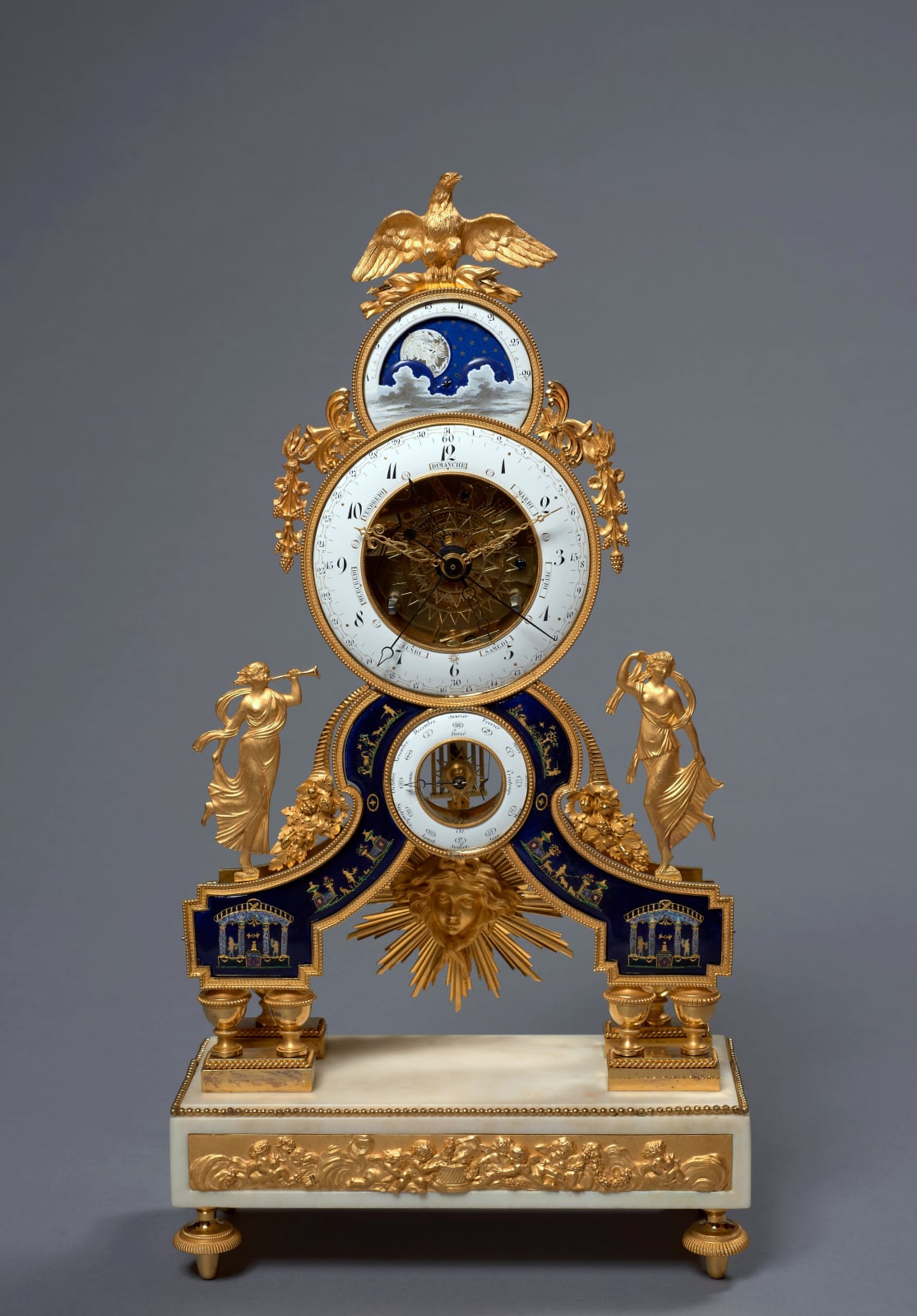Unknown
Literature
Literature: Tardy, “Les Plus Belles Pendules Françaises”, 1994, p. 206, colour pl. XLII, illustrating a comparable Directoire skeleton clock with enamel work by Joseph Coteau in the Musée des Arts Décoratifs, Paris. Pierre Kjellberg, “Encyclopédie de la Pendule Française du Moyen Age au XXe Siècle”, 1997, p. 319, pl. B, illustrating a similar but less ornate skeleton clock by Ridel à Paris in the Musée François-Duesberg, Mons, Belgium, with enamel work by Joseph Coteau dated 1796 and featuring a very similar gilded frieze in the style of Clodion. Johann Willsberger, “Clocks and Watches, 600 Years of the World’s Most Beautiful Timepieces”, 1975, introductory page, illustrating another comparable skeleton clock by Ridel à Paris.
An extremely beautiful and fine quality Directoire gilt bronze, enamel and white marble skeleton clock of eight day duration, with three dials each within a beaded bezel, the main white enamel dial ring with Arabic numerals and an outer calendar ring numbered 1-31 with inner names of the days of the week interspersed by their respective signs, with a fine pair of pierced gilt brass hands for the hours and minutes and two blued steel pointers to indicate the days of the month and days of the week, the main dial surmounted by a lunar dial marked 1-29 ½ for the lunar calendar and centred below by a grisaille moon set against a blue gilt star studded sky above clouds, with a second subsidiary dial below the main dial to show the names of the months, signs of the zodiac and the four seasons, each indicated by a single blued steel pointer.
The main dial with a cut out centre to reveal the skeletonised twin barrel movement with pin wheel escapement, knife edge suspension, striking on the hour and half hour on a single bell, with outside count wheel and a magnificent Apollo mask sunburst pendulum. The equally wonderful case surmounted above the lunar dial by the personification on Jupiter as an eagle with wings outstretched who stands upon a cloud enclosing a thunderbolt, the outer part of the lunar and main dial ornamented by fruiting and floral pendants, the main dial upon a shaped arched blue enamel frame enclosing four gilt and polychrome painted hunting scenes above a pair of painted temples, the arched frame flanked either side by a gilt bronze upturned cornucopia from which spill fruiting vines which are both bordered by a young maiden, the one on the left blowing a trumpet and the one on the right dancing, the arched frame on urn-shaped supports on a rectangular white marble base with beaded border centred by a gilded frieze showing playing putti in the style of Clodion, supported on toupie feet
Paris, date circa 1795
Height 53 cm, width 28 cm, depth 12 cm.
A similar clock, signed on the dial Laguesse à Liège with equally beautiful enamel work by the preeminent enamel painter Joseph Coteau (1740-1812), dated 1796 is housed at Pavlovsk Palace, Saint Petersburg (inv. no. 4177-IV; illustrated in Emmanuel Ducamp, “Pavlovsk, Les Collections”, 1993, p. 186, pl. 17). As here it has three dials, it is surmounted by an eagle upon a thunder bolt and features the same gilt bronze frieze on its base.
Interestingly that clock and the other similar one by Ridel in the Musée François-Duesberg as well as another by Ridel sold by this gallery (illustrated in “Richard Redding Masterpieces of the Past”, 2009, p. 40-41) all have enamelwork by Coteau dated 1796. Given the similarity between this skeleton clock and specifically the quality of its enamelwork, it is very probable that the present enamelling was also executed by Coteau.
